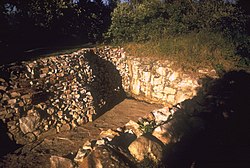Pipestone National Monument
|
Cannomok'e--Pipestone National Monument
|
|
 |
|
| Location | Sweet Township, Pipestone County, Minnesota |
|---|---|
| Nearest city | Pipestone, Minnesota |
| Coordinates | 44°0′48″N 96°19′30″W / 44.01333°N 96.32500°WCoordinates: 44°0′48″N 96°19′30″W / 44.01333°N 96.32500°W |
| Area | 281.78 acres (1.14 km²) |
| Visitation | 69,820 (2005) |
| Website | Pipestone National Monument |
| MPS | Pipestone County MRA (AD) |
| NRHP Reference # | 66000112 |
| Significant dates | |
| Designated HD | October 15, 1966 |
| Designated NMON | August 25, 1937 |
Pipestone National Monument is located in southwestern Minnesota, just north of the city of Pipestone, Minnesota. It is located along the highways of U.S. Route 75, Minnesota State Highway 23 and Minnesota State Highway 30.
The catlinite, or "pipestone", has been traditionally used to make ceremonial pipes, vitally important to traditional Plains Indian religious practices. The quarries are sacred to most of the tribe of North America, Dakota, Lakota, and other tribes of Native Americans, and were neutral territory where all Nations could quarry stone for ceremonial pipes. The Sioux tribes may have taken control of the quarries around 1700, but the Minnesota pipestone has been found inside North American burial mounds dating from long before that, and ancient Indian trails leading to the area suggest pipestone may have been quarried there for many centuries.
As the United States grew westward in the 19th century, pipes found their way into white society through trade. To protect their source, the Yankton Sioux secured free and unrestricted access via The Treaty With The Yankton Sioux, which was signed on April 19, 1858.
The land was acquired by the federal government in 1893. In 1928, the Yankton Sioux, then resettled on a reservation 150 miles (240 km) away, sold their claim to the federal government. The National Monument was established by an act of Congress on August 25, 1937, and the establishing legislation restored quarrying rights to the Indians. Today only people of Native American ancestry are allowed to quarry the pipestone. A boundary change occurred on June 18, 1956. As an historic area under the National Park Service it was administratively listed on the National Register of Historic Places under the heading "Cannomok'e—Pipestone National Monument". The Red Pipestone Quarries within the monument comprise a Minnesota State Historic Site.
...
Wikipedia


